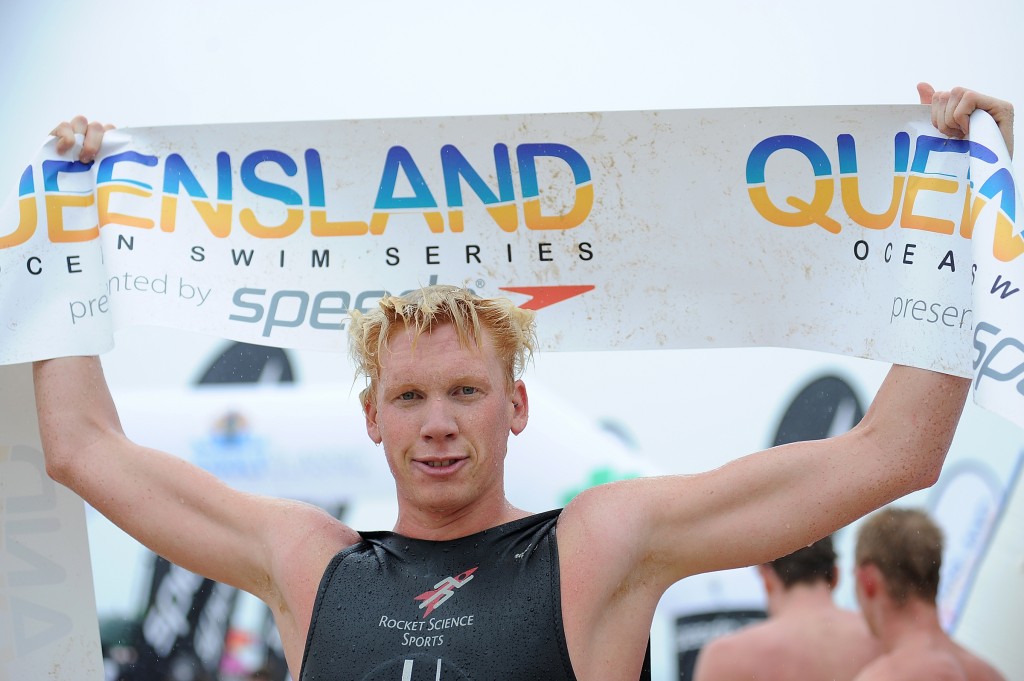Cooly Classic Training
Pack swimming, drafting, sighting…these aren’t critical when doing laps at your local pool, but if you’re tackling an ocean swim like the Cooly Classic, we think it’s worth arming yourself with some tips & tricks.
Codie and Trent Grimsey are the open water specialists and below are their tips for open water swimming.
The Start:
- Always wear a new pair of goggles or a pair of goggles you know will not fog up (never race in your training goggles).
- On the start line always position yourself directly beside someone you know is slightly faster than you.
- When the race begins, get in the slip steam of that swimmer straight away (directly behind him or her) and stay there for as long as you can.
- Don’t be aggressive (it wastes too much energy).
- Think happy thoughts.
Pack Swimming:
- Don’t be afraid of it.
- In ocean swims packs will always be very tight and rough. If you’re a stronger swimmer you can get away with swimming on the outside of the pack, where there will be a little less drag. You will have a lot more room to move and will not have to be jostling with someone either side of you the whole way. If you’re a weaker swimmer it will be more beneficial to sit in the middle of the pack working as hard as you can to stay there. Getting dropped can make it a long and lonely swim.
- If someone hits you or is annoying you don’t hit or annoy them back – just swim away from them. If you get angry with them it will just take your focus and energy from your race. Don’t even try and look at who it is as it will only make you even angrier. Just swim away from them and pretend it never happened.
- Conserve, conserve, conserve . . .
- When you’re swimming in the pack you shouldn’t have to lift your head to site buoys much at all. The person leading the pack will do that and everyone else just follows him/her.
- If you’re leading the pack lift your head every 4 – 6 strokes just to make sure you’re keeping a straight line.
Sighting:
- A big mistake a lot of swimmers make is trying to breathe while sighting. This is a big no-no. You sight then turn your head to the side to breathe.
- When sighting, you only want the bottom of your goggles to be above the water. Lifting your whole head out causes your hips to drop, which causes drag and breaks up the rhythm of your stroke.
Drafting:
- When drafting behind someone you want to be as close to them as possible without touching their feet (touching their feet will just annoy them and it takes away the element of surprise). You’ll get more of an advantage and save more energy drafting off someone.
Turning Buoys:
Turning buoys are the most important thing in any race. They’re where you can make up a lot of ground or potentially lose a lot of ground . . .
- When turning a buoy you want to be as close to the buoy as possible (the closer you are to the buoy the less distance you have to swim)
- Do not lift your head when turning a buoy (unless you want it knocked off)
- 15-20 meters before a turning buoy pick up the pace. You want to have fast momentum when turning a buoy.
- Things will get rough around the buoys but hold your ground and you’ll be fine.
Last turning Buoy (home straight):
- When you turn the last buoy you will be hurting but you have to remember that everyone else is hurting just as much as you are.
- If you can see it’s going to come down to a sprint finish and you’re in front start to zigzag. It will make it harder for people to overtake you.
- If it comes down to a sprint finish this is the only time it is okay to get a bit physical with one of your competitors. It’s better if you start getting physical with them before they start getting physical with you. This way they know you’re in control of the race, not them. It’s also letting them know you won’t be a pushover.
Things to remember:
- Simplicity . . . keep it simple
- When you feel yourself starting to hurt or fall apart, whether it is in training or a race, go back to basics. Remember all the small things (the catch, the pull, touching your thumb on your thigh every stroke, high elbows, body position . . .).
- Only worry about things you can control . . . you can’t control your competitors so don’t worry about them.
- In open water swimming the fastest doesn’t always win or come out the water first, the smartest does. Race smart!
Swim Sessions to Go
Developed by professional swimmers, Trent and Codie Grimsey, Swim Sessions To Go is perfect for the swimmer who is looking to improve and train anywhere, anytime!
Available in 1, 5 and 10 swim packages starting from $10, detailed training programs are sent at the click of a button
www.swimsessionstogo.com
